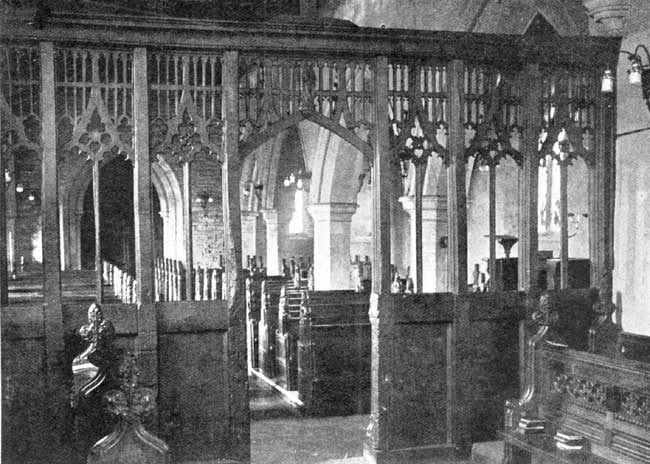< Previous
The Rood Screen in Balderton Church.
By Rev. A. Du Boulay Hill.

Balderton–East face of screen.
THE oak rood-screen in Balderton Church, which I think has not hitherto been described, has recently been cleaned and renovated at the expense of an anonymous donor. Several coats of paint and varnish have been removed, and a considerable amount of patching in white deal has been replaced with oak. It had previously been taken down during the rebuilding of the chancel arch in 1882 when it underwent rather drastic reparations. It now stands on a new 5in. lintel under each half. It is 11ft. 9½ins. in height, and 17ft. from wall to wall.
This screen bears a great resemblance to that at Wysall1 in this county, which has been dated about 1440. It is rectangular in construction, with a central opening of 3ft. 4ins., and three compartments on each side about 2ft. 2ins. centre to centre. The moulding of the standards runs through continuously from the lintel to the moulded bases, with the exception of the two central standards on either side of the gateway, in which the horizontal moulding is returned as a collar round them ; while the middle rail 9½ins. in height is framed in sections between the standards. The vertical lines are thus most prominent here, whereas at Wysall the horizontal rail dominates the design. The upper portion of the front moulding on the standards has been renewed, so there may have been some provision for a coving beneath the loft.
The central opening, under a four-centred arch, was originally provided with low gates capped with a continuation of the middle rail. The three compartments on either side have each a steep crocketted ogee arch, rising to a finial under the lintel, behind which the square heads of all the compartments are filled with two rows of perpendicular trefoiled openings. Beneath the ogee each compartment is divided by a mullion into two cinquefoil-headed lights. The cusps of the ogee and sub-arches meet in a central rosette variously carved with lion's face, rose, etc.
The six panels of the screen have been replaced (1882) with plain modern oak, but the inner moulding of the muntins indicates tracery planted on the upper third of the original panels.
The eastern face of the screen is without any mouldings on the standards or the tracery. Some plugged-up mortise holes indicate the position of returned stalls against the back of the screen. As there are no marks of the hinges of the screen gates on the standards it is probable that they were affixed to the ends of these stalls.

Figures on screen in Balderton church.
A curious feature of the screen is the presence of two small figures standing on pedestals placed at the point of the central arch. On the eastern face the figure is that of Our Lady suckling the Holy Child, beautifully carved in oak, 13ins. in height. The figure on the western face represents St. Francis, his left foot resting on a globe with crossed bands, taken as the arms of his order. This is of elm, 16ins. high. After close inspection I cannot think that they are part of the original design of the screen. The pedestals on which they stand have been renewed; the bracket on the east is fixed to the flat tracery, and the figure on the west side appears to stand upon a truncated finial.
Mr. Aymer Vallance considers the Madonna to be late 15th or early 16th century Flemish or N. French work, later than the screen which is of the first half of the 15th century. The St. Francis he considers to be the work of a less skilled hand of the late 16th or the 17th century. His long pointed hood is that now adopted by the Capuchin friars as the original form of the habit.
I am greatly indebted to the careful observation and photographs of the screen made by Mr. R. W. Emerson, of Balderton, during the progress of the recent work. I add a few notes upon other wood carving in this church which is exceptionally rich in 15th century woodwork fittings.
The panelled pulpit is of the same period as the screen, and also the fine set of forty-two bench ends in the nave, though these are the product of a more fantastic brain. They are remarkable for having rabbits or dogs in pairs, head downwards, or sometimes human figures, carved on either side of the poppy heads, and rather stiff tracery patterns on the flat face. Of these, twenty-six are double-shouldered, and had a back rail mortised in the centre of the bench end, so that the very stout bench served a double purpose, affording not only a seat, but a broad kneeling board for those who sat behind it, which though high according to modern ideas, would not be uncomfortable for those who were used to them. The other sixteen ends are single-shouldered and would form the front and back ones of four blocks of seats.
The door in the inner archway of the Norman porch (rebuilt) is similar to the west door at the neighbouring church of Hawton, with its unusual interlacing tracery pattern, and transom with "Jesu mercy lady help," in raised lettering. It has also a mutilated figure carved in the central tracery opening. This is of quite the end of the 15th century.

< Previous
(1) Described and illustrated by Mr. Vallance in Memorials of Old Nottinghamshire, p. 166.
